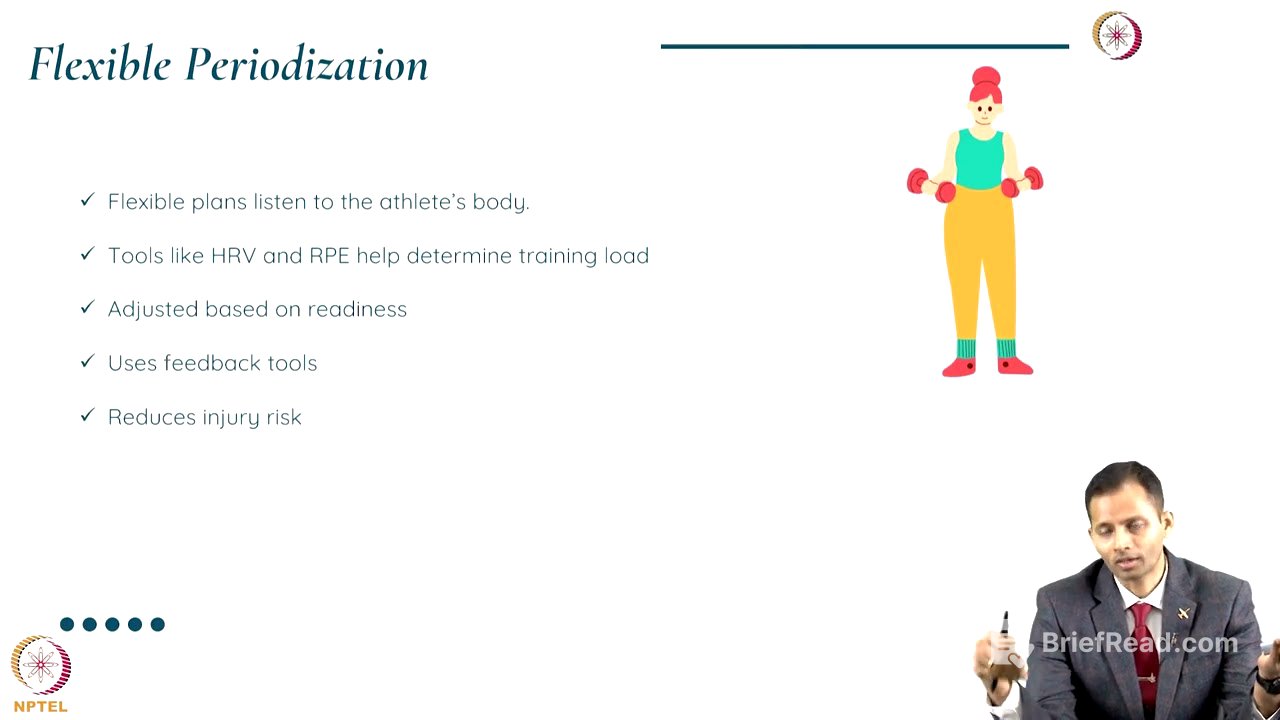TLDR;
This lecture provides a comprehensive overview of periodization in strength training, explaining its principles, models, and practical applications. It emphasizes the importance of structured training programs, adaptation, recovery, and variability to enhance performance and reduce injury risk. The lecture also covers different periodization models, training cycles, and the manipulation of training variables to achieve specific strength goals, aligning them with various training phases and sports requirements.
- Periodization is a systematic process of sequencing training methods to achieve peak performance.
- Key principles include progressive overload, specificity, variation, and recovery.
- Different periodization models are linear, nonlinear, block, and flexible.
- Training cycles are divided into macrocycles, mesocycles, and microcycles.
- Variables like frequency, intensity, type, time, progression, and volume are manipulated to achieve specific strength goals.
Introduction [0:15]
The lecture addresses how to design a strength training program for a college athlete, considering factors like periodization. It aims to explain the principles of periodization, its methods in sports, and how to periodize strength training using various variables, including practical case scenarios.
Defining a Successful Program and Periodization [1:34]
A successful program is structured to stimulate adaptation, provide adequate recovery, enhance performance, reduce plateaus, and minimize injury risk. Periodization, a logical and systematic process of sequencing training methods, is central to achieving peak performance. It involves changing training variables to reduce burnout, prevent injury, and optimize performance. Leoned Matveyev is considered the father of periodization, introducing these concepts in the 1960s. The principle follows the general adaptation syndrome, involving stimulus, recovery, and adaptation.
Scientific Rationale and Principles of Periodization [3:44]
The body responds to stimuli through alarm, resistance, and exhaustion. Adaptation occurs as resistance to the stimuli, leading to super compensation with adequate recovery. Insufficient recovery or excessive stimuli results in exhaustion or overtraining. Periodization uses this process in a planned, progressive manner for effective training. Key principles include progressive overload, specificity (energy system, strength goal, muscle group), variation (frequency, intensity, type, modality, volume, progression), and recovery. Variation prevents monotony and overuse, while adequate recovery allows the body to adapt, preventing overtraining and ensuring desired results.
Types of Periodization Models [6:46]
Four main periodization models are used: linear, nonlinear (undulating), block, and flexible (variable). Each has benefits and is chosen based on the training phase, athlete level, and sport. Linear periodization involves a gradual increase in intensity and a decrease in volume, suitable for beginners and those returning from rehabilitation. Nonlinear periodization, used for elite athletes, involves frequent changes in volume and intensity, even daily or weekly, to maintain multiple fitness traits. Block periodization focuses on developing specific motor qualities in blocks, such as accumulation, transmutation, and realization, to peak at the right time. Flexible periodization adjusts volume and intensity based on the athlete's response, monitored objectively or subjectively, reducing injury risk.
Training Cycles and Variables [10:17]
Any periodization model must adhere to a training cycle, like the four-year Olympic cycle or an annual academic program. The macrocycle is divided into mesocycles and microcycles (weekly sessions). Periodization starts with planning annual cycles and aligning goals. Variables for gradual overloading include frequency, intensity (percentage of one-rep maximum), type (free weight, machine, whole body weight), time (session duration), progression (volume or intensity), and volume (repetition, sets, rest interval). Manipulating these variables helps achieve specific strength goals like strength, hypertrophy, or endurance.
Periodizing for Specific Strength Goals [13:04]
For strength endurance, use low intensity and high volume (repetitions). For maximum strength or hypertrophy, use maximum load or intensity, moderate repetitions, and a slow tempo for sustained tension. For power training, use 40-60% intensity, moderate repetitions, and a fast tempo. Each goal requires a different strategy.
Periodization Periods and Training Phases [15:29]
The annual training cycle is divided into macrocycles, mesocycles, and microcycles, with transition phases. Training phases include preparatory, pre-competitive, competitive, and transition/recovery. In the preparatory phase, develop basic strength with low to moderate intensity and high volume, focusing on endurance and hypertrophy. The pre-competitive phase focuses on strength and power, moving towards sport-specific gains with higher load and lower volume. The competitive phase employs peaking and tapering strategies. Peaking maximizes strength and power for a short period, while tapering reduces training volume for recovery and super compensation. Maintenance strength training is used between competitions to maintain developed qualities with moderate to high intensity and moderate volume. The postseason or recovery phase involves active rest with extremely low intensity and volume to prevent detraining.
Peaking and Tapering [19:58]
Peaking maximizes strength and power for a short competition period, but prolonged peaking can lead to overtraining and injuries. Tapering reduces training volume after peaking to enhance recovery and improve performance. Tapering mainly cuts volume but maintains intensity, especially before competition.
Periodization in Team Sports, Power vs. Endurance Sports [21:12]
In team sports, the preparatory phase is the offseason, focusing on strength and hypertrophy. The pre-competitive phase is the preseason, focusing on power and maximum strength. The in-season is the competitive period, maintaining performance with various periodization models. The postseason involves active rest to maintain basic levels and prevent detraining. Both power and endurance sports benefit from strength training. Power sports require explosive power generation with short, intense sessions (85-100% of 1RM) and longer rest intervals. Endurance sports emphasize speed and interval training, incorporating strength training as concurrent training with two to three sessions per week and shorter rest intervals.
Periodization in Sports Rehabilitation [24:22]
Periodization in sports rehabilitation aligns with tissue healing and rehabilitation phases. It emphasizes quality over load, gradually increasing load with caution, considering the tissue's physiological status. Periodic assessments provide feedback on progress.
Case Scenario and Conclusion [25:06]
When designing a strength training program for a college athlete, consider the athlete's profile (past experience, training age, conditioning status, past injuries), the demands and strength goals of the sport, and the annual training cycle. Align strength goals with microcycles and mesocycles, varying volume and intensity accordingly. Periodization prevents injury and burnout, helps peak at the right time, and achieves appropriate strength training goals through variable manipulation and monitoring. Aligning strength training goals with training phases ensures a successful outcome.









